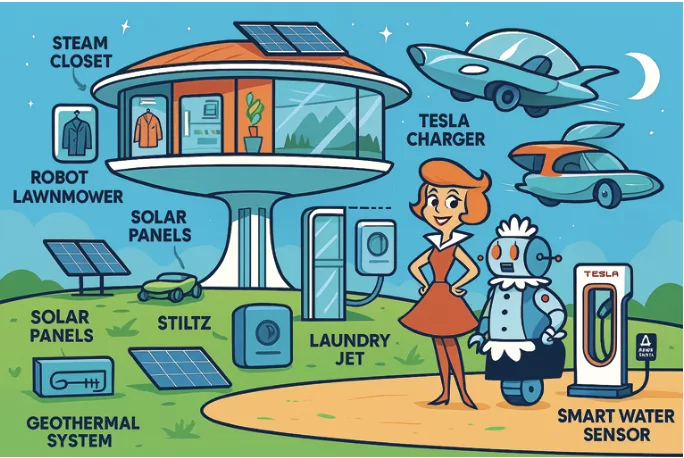By John Engel
What is a smart home? If “smart” means convenience, efficiency, security, and comfort, let’s start with something dumb: the closets, often overlooked. The smartest, most efficient closet I ever saw was Tommy Hilfiger’s in Greenwich back in 2009. I saw only a few white shirts. I thought, This cannot be. It wasn’t. Turns out, next to the white shirts were the blue ones, then the pink ones, and so on — hundreds of shirts, travelling up through a gap in the ceiling into the attic on a motorized dry-cleaners conveyor. Closet heaven. The epitome of efficiency and convenience. Rather than enlarge Tommy’s closets to impractical size, let’s put Tommy’s shirts in the attic. Instead of making Tommy climb stairs, bring the clothes to Tommy. Estimated price for a dry-cleaner conveyor installed in your home: $15k – $400k. But I ask again, is this a smart home, or just a mechanical one?
Wine cellars are getting smarter and are now so much more than climate-controlled storage. Those in a museum want education: Who made it and when, and why should I care? So too with wine — we enjoy it more when we know the whole story: terroir, grape, vintage and vintner. The very best wine cellars go beyond boring inventory control to tell the story of each bottle, what’s it worth, how reviewed, and when to drink it. Smart homes kick it up a notch: if Chianti is best in Chianti, let’s project a 3D hologram of the Tuscan Hills, Napa Valley, or Mendoza on the glass walls of the cellar. These are cellars to entertain and inform, but are they smart?
Speaking of glass walls, here’s a sidebar. For 99.9% of human history, a wall’s major purpose was to hold up the building. No longer, and not for the last 100 years. When Louis Sullivan ushered in the first “curtain walls” of glass in Chicago, we were free of that convention. Or so Philip Johnson thought when he built a glass house. He said glass walls are the world’s most expensive wallpaper, but Philip didn’t have 3D holograms, so very next level.
Therefore, given curtain walls and technology allowing modular spaces, why have smart homes regressed to stick-built colonials, built out in the weather, one at a time, and not particularly ecologically, economically, or sustainably smart? But I digress.
The National Association of Realtors 2023 “Smart Home Technology Report” found that smart features can increase resale value by 3-5%, saying these features are more valued by Millennials and Gen Z than they are by older buyers. But a May 2023 WSJ article contradicts this, saying smart tech might make a home more desirable but rarely translates to a proportional increase in sale price. They cite high-end systems like Crestron and Lutron costing $15,000+ but criticize even simpler, cheaper upgrades like Nest thermostats and Ring cameras as a turn-off. Why? Tech-heavy homes may risk deterring buyers who prefer simple wall switches. Most of us don’t want anything too fussy or complicated, certainly nothing that requires re-education, and when smart is complicated, this is the reason buyers won’t pay up for it.
In 2024, 60% of new condos in Fairfield County offered smart tech, up from 45% in 2023. Homes with smart features sold 20% faster in 2024 (NewHomeSource) and are expected to sell 25% faster this year.
Energy management and fuel efficiency is the biggest driver of smart home technologies. Thermostats know who’s home and what’s the weather outside, and adjust accordingly. It’s considered “smart” to convert from oil (70%-80% efficiency) to cleaner natural gas (90% -98%) or super-high-efficiency heat pumps (HSPF 10 equals 293% efficiency). My geothermal heating and cooling system (400% efficiency) added about $50,000 in expense but paid for itself in less than 5 years by reducing fuel bills by nearly $1,000 per month. An efficient home is a smart home.
Scott Hobbs, custom builder, says “Load Shedding” is a smart home idea. Smart generators employ power-management strategies that ensure critical systems remain powered by prioritizing essential loads (refrigerator, heating) over the hot tub and the dryer and manage increased start-up loads while not having to oversize for unusual conditions.
Is the ($14,000) Tesla Powerwall 3 (13.5kWh) “smarter” than Scott’s smart generator? Probably. Not only useful during an outage, but when combined with high-efficiency solar panels ($11,000 for 4kW) and power-management software, it will manage the load as well as schedule your electric vehicle charging after midnight for less and sell the excess power back to the grid. (At 30 cents per kWh, solar payback is currently 7-10 years, only marginally smart.)
Smart speakers are a $10 billion market, a strong indication of smart home ecosystem adoption. This market is currently dominated by the Amazon Alexa (65% market share, 500 million sold) and Google Nest (23% share), with the Apple Homekit (10% share) a distant third.
Sonos’ $1.6 billion in sales lead the premium audio space category with an estimated 15-20 million devices in 7-8 million U.S. households, offering multi-room systems priced from $180 (Roam 2) to $899 (Arc).
Apple’s HomePod ($299) targets audiophiles wed to Apple’s Homekit system, while Bose offers high-fidelity sound to Alexa or Google Assistant homes.
How did Amazon win over my mother? With a free hockey-puck sized speaker and mastery of one command: “Alexa, play more Frank Sinatra.” In my house, Apple’s HomeKit turns on lights and music in the morning, changes playlists every two hours, and turns the lights off at bedtime. But it is not smart, merely automated and no smarter than a dimestore mood ring. I love John Coltrane, but not at bedtime. The WSJ complaint this week that Alexa+ and Apple AI haven’t arrived resonates.
So, what is smart and interesting?
Stiltz is a freestanding compact elevator for your home, $25,000 installed, and less with a 30% tax credit. Reddit’s spinal cord injury community calls it life-changing.
LaundryJet is a central vac for your laundry, sucking it through 6” tubes in the walls, depositing it in the basement. For those of us who saw Willy Wonka’s Chocolate Factory, this version is child-proof and pet-proof.
Samsung smart refrigerators have touchscreens and interior cameras to check food remotely. Boring. I’ve never seen a smart refrigerator in New Canaan.
Electrochromic glass tints automatically, improving efficiency and eliminating the need for blinds. At $70 to $150 per square foot, smart glass is expensive.
Flo by Moen smart water monitor ($529 plus install) detects leaks and shuts off the water, thus potentially preventing massive damage. Meredith Bach, now of Howard & Gay Insurance, says it will lower your insurance and is a required feature on many new homes.
The LG Styler steam closet sanitizes, steams, and de-wrinkles clothes. Too bad we’re all dress-down casual and work from home. This was smart back in the 1950’s.
Robot lawn mowers (Husquevarna $5900), with 3 million sold, have not caught on around here. Smart enough to avoid obstacles and learn boundaries, they’ll silently mow your 2.5 acre lawn with a 50% slope in the same checkerboard pattern as Yankee Stadium. Silently sounds nice.
Since the functions of the smart home so quickly become necessities, the smart home requires constant updating to remain smart and not be taken for granted. It reminds me of a Don Draper quote from Mad Men: “What is happiness? It’s a moment before you need more happiness.”
John Engel says The Engel Team at Douglas Elliman just got a little smarter this week with the addition of Deke Rothfuss, 38-year veteran of Goldman Sachs. If municipal bonds are the quiet librarians of the investment world—reliable, tax-efficient, and a little dull—then real estate is their louder, better-dressed cousin who shows up with blueprints, tax shelters, and an Airbnb side hustle. Muni bonds might fund a school, hospital, or fire station. Real estate is the school, hospital, or house—same town, same benefit, different way to hold value.





